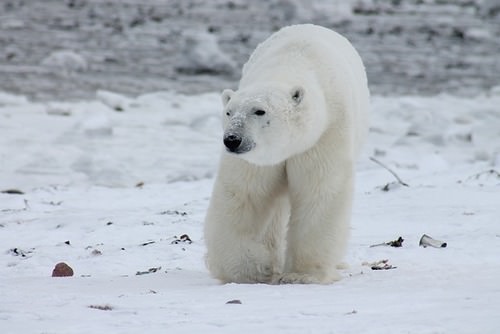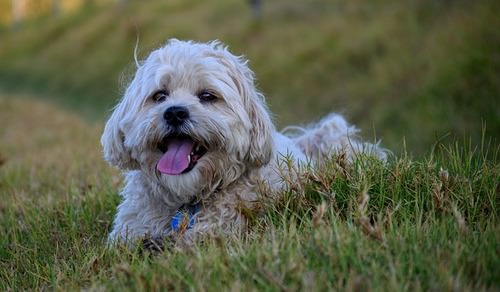16.39 哺乳动物的外鼻腔 -- -- 高级
章节大纲
-
Is this bear cold?
::这是熊冷吗?Not really. Like all mammals , polar bears maintain a stable internal temperature. They do not need to stay warm by lying in the sun. This allows them to live in cold climates.
::不像所有哺乳动物一样,北极熊保持稳定的内温。它们不需要躺在太阳下而保持温暖。这样它们就可以生活在寒冷的气候中。Endothermy
::另类Virtually all mammals are endothermic. Endothermy is the ability of an organism to generate and conserve heat in order to maintain a stable, warm body temperature. This ability is commonly referred to as warm-bloodedness. Another term that is used to refer to endothermic is homeothermy. Although homeothermy and endothermy are often used interchangeably, their meanings are not exactly the same. Homeothermy is the ability of an organism to maintain a constant internal body temperature, regardless of the temperature of the environment. This may require the ability to lose excess heat as well as the ability to generate and conserve heat. Most mammals have both abilities.
::几乎所有哺乳动物都是局部热学。 局部热学是有机体产生和保持热量的能力,以便保持稳定的温暖身体温度。 这种能力通常被称为热血。 指内热的另一个术语是家庭热学。 虽然家庭热学和外热学通常可以互换使用,但其含义并不完全相同。 人体热学是生物体保持恒定体内温度的能力,不管环境温度如何。 这可能需要丧失超热的能力以及产生和保持热力的能力。 大多数哺乳动物具有两种能力。Generating Heat
::正在产生热热Mammals generate heat primarily by maintaining a high metabolic rate. The metabolic rate is the speed at which chemical reactions occur in the of the body. A faster rate of chemical reactions in results in the production of more heat. For example, doubling the metabolic rate leads to an increase of about 10 o C in body temperature. How are mammals able to maintain such high metabolic rates? Mammalian cells have many more than the cells of other vertebrates . Mitochondria are the “power plants” of cells. They generate most of the cells’ ATP , which is their main source of chemical energy . Having more of these tiny power plants in their cells enables mammals to produce the extra energy needed to maintain a high metabolic rate.
::哺乳动物主要通过保持高代谢率来产生热量。代谢率是身体中化学反应的速度。 更快的化学反应率导致更热的产生。 例如, 代谢率翻番导致身体温度上升约10°C。 哺乳动物如何能保持如此高代谢率? 哺乳动物细胞比其他脊椎动物细胞的细胞多得多。 米托贡德里亚是细胞的“电厂 ” 。 它们产生大部分细胞的ATP,这是它们的主要化学能源来源。 这些小电厂在细胞中拥有更多的能让哺乳动物产生维持高代谢率所需的额外能源。Mammals can also temporarily generate more heat by shivering . Shivering is involuntary muscular activity that converts some of the body’s energy to heat. Like most responses that regulate body temperature in mammals, shivering is controlled by the hypothalamus in the brain . The hypothalamus internal body temperature directly. It also has input from temperature sensors in the skin. When the temperature is too low, the hypothalamus signals to contract. This muscular activity produces heat. The next time you shiver, notice how most of the muscles in your body seem to tighten up all at at once. The many simultaneous muscle contractions can generate a significant amount of heat.
::哺乳动物也可以通过颤动临时产生更多的热。 颤动是非自愿的肌肉活动,可以将身体的某些能量转换为热能。 和控制哺乳动物身体温度的大多数反应一样,颤动是由大脑的下丘脑控制的。 脑部的下丘脑温度直接由脑部控制。 皮下脑部的体温也来自皮肤温度传感器。 当温度过低时, 皮下脑信号会萎缩。 这种肌肉活动会产生热力。 下次你颤动时, 注意身体中的大多数肌肉似乎同时会收紧。 许多同时发生的肌肉收缩可以产生大量热力。Mammals raise their hair with tiny muscles in their skin. Even humans automatically contract these muscles when they are cold. They cause “goosebumps,” as shown here. Conserving Heat
::保护热油Generating heat is only part of the story. Conserving heat is also important for most mammals to maintain a warm body temperature. In areas with cold weather , heat loss may be a major threat to homeothermy, especially in small mammals. Heat is lost to the environment through the body’s surface when the environment is cooler than body temperature. If the body’s surface area is large relative to overall body size, a greater proportion of heat will be lost. Small animals have a large surface area relative to body size, so they lose relatively more body heat than large animals.
::发热只是故事的一部分。 保存热量对于大多数哺乳动物保持温暖的体温也很重要。 在寒冷的气候地区,热量流失可能是对家庭体温的主要威胁,特别是小哺乳动物。 当环境比身体温度冷的时候,热量会通过身体表面消失在环境中。 如果身体的表面面积相对于整体体积而言很大,那么热量就会减少。 小动物的表面面积比身体体积大,因此它们的体温会比大动物少得多。There are several adaptations that help mammals reduce heat loss from their body surface. Hair or fur is one way. It traps a layer of warm air next to the skin, which acts like insulation. Most mammals have the ability to make their hair stand up on their skin (see Figure ), allowing a thicker layer of warm air to be trapped. This is accomplished by tiny muscles, called erector muscles, which are attached to hair follicles . Did you ever get “goose bumps” when you were cold? These tiny bumps are caused by the erector muscles lifting hair follicles in the skin. Another form of insulation in mammals is fat. Unlike the skin of other vertebrates, the skin of mammals normally has a layer of fat beneath it. This layer, called subcutaneous fat, helps insulate the body and hold in heat.
::哺乳动物可以减少身体表面的热损耗。 毛发或毛皮是一种方法。 它将一层温暖的空气困在皮肤旁边, 与绝缘一样。 大多数哺乳动物都有能力将头发放在皮肤上(见图 ) , 使更厚的温暖空气层能够被困住。 这是由微弱的肌肉, 叫做勃起肌肉, 与毛囊相连。 当你寒冷时你有没有得到过“ 鹅斑点 ” ? 这些微小的肿点是由勃起的肌肉在皮肤上抬起毛发囊造成的。 另一种哺乳动物的绝缘形式是脂肪。 与其他脊椎动物的皮肤不同, 哺乳动物的皮肤通常在皮肤下有一层脂肪。 这个叫做亚丁脂肪的层, 有助于将身体隔热。Mammals can also conserve heat by reducing flow to the surface of the body. Blood normally carries heat from deep inside the body to the body’s surface. Therefore, reducing blood flow to the surface cools the surface and reduces heat loss. Capillaries, which are the smallest , can narrow, or constrict, when the body is too cold. This process, called vasoconstriction, is controlled by the hypothalamus. It helps conserve body heat.
::哺乳动物也可以通过将血液流到身体表面来保持热量。 血液通常会把热量从身体深处传到身体表面。 因此,将血液流减少到表面会让表面冷却,减少热量流失。 最小的哺乳动物可以在身体太冷时缩小或收缩。 这个过程被称为血管收缩,由皮下脑控制。 它有助于保护身体的热量。In extremely cold conditions, excessive vasoconstriction can cause numbness and even frostbite in the extremities such as the fingers, toes, nose, or ears. This is because excessive vasoconstriction shuts down virtually all blood flow to the extremities. Without any blood flow, cells cannot function and quickly die.
::在极端寒冷的条件下,过量的血管收缩可能导致麻木,甚至会在手指、脚趾、鼻子或耳朵等极端地方造成冻结。 这是因为过量的血管收缩使几乎所有的血液都无法流向极端地区。 没有血液流动,细胞就无法正常运转和迅速死亡。Staying Cool
::保持冷静Most mammals also need to be able to cool down in order to avoid overheating when they are very active or their environment is very warm. Did you ever get red in the face when you were physically active on a hot day? If you did, then your skin was flushed, an indication that your body was trying to lose excess heat. The skin flushes, or reddens, because more blood is flowing close to the surface. This happens because capillaries near the body’s surface widen, or dilate. This process, called vasodilation, warms the skin and allows more heat to be lost to the environment. It is the opposite of vasoconstriction. Like vasoconstriction, it is controlled by the hypothalamus.
::大部分哺乳动物也需要冷静下来以避免过热, 当它们非常活跃或环境非常温暖的时候。 当你在炎热的一天身体活跃的时候,你有没有在脸上发红? 如果你这样做,你的皮肤被冲洗, 表明你的身体正试图失去超热。 皮肤冲浪, 或红洞, 因为更多的血液在靠近表面流动。 发生这种情况的原因是, 身体表面周围的刺青扩大, 或膨胀。 这个过程叫做血管变暖, 使皮肤变暖, 并允许环境失去更多的热量。 这是血管收缩的对面。 和血管收缩一样, 它受下丘的控制。Many mammals also lose excess heat by sweating. Sweat is a watery fluid produced by sweat glands in the skin. When the skin is wet with sweat, evaporation of the sweat cools the body. This is because the process of evaporation uses energy, which comes from heat in the skin. By using up excess heat, evaporation of sweat helps lower body temperature. In humans and many other mammalian , sweat glands cover most of the body surface. Sweating is controlled by the hypothalamus, which stimulates sweat glands to either increase or decrease their sweat output, depending on body temperature.
::许多哺乳动物也因出汗而失去过多的热量。 汗水是皮肤中汗水层产生的水体。 当皮肤被汗湿时, 汗水蒸发会使身体冷却。 这是因为蒸发过程需要能量, 能量来自皮肤的热量。 通过使用过热, 汗水蒸发有助于降低体温。 在人类和许多其他哺乳动物中, 汗水层覆盖了大部分身体表面。 湿气是由下丘体控制的, 水能刺激汗水层增加或减少其汗水输出, 取决于体温 。In mammals whose skin is covered with fur, sweating is not an efficient way to lose excess body heat. When skin is not exposed to the air, sweat cannot evaporate. Instead, furry mammals usually rely on panting to lose heat. Panting involves rapid , generally with the mouth open and tongue extended, as shown in Figure . Evaporation of from the moist surfaces of the lungs , mouth, and tongue uses up heat energy and helps cool the body.
::在皮肤被毛皮覆盖的哺乳动物中,汗流不是失去过热体温的有效方法;如果皮肤不暴露在空气中,汗水就无法蒸发;相反,毛皮哺乳动物通常依靠喘气而失去热量。 气喘是快速的,一般是嘴张开和舌头伸展,如图所示。 从肺部、嘴部和舌头湿润表面的蒸发可以增加热能,帮助身体降温。This dog is overheated. It is losing excess body heat by panting. Costs and Benefits of Endothermy
::替代物的成本和效益Constantly adjusting body temperature requires a lot of energy. Increasing the rate of metabolism is especially energy intensive. As a result, endothermic animals typically need more food than ectothermic animals. Ectothermy means controlling body temperature through external means, for example, by absorbing heat from sunlight. An endothermic animal may require five to ten times as much food as an ectothermic animal of the same size. Endothermic animals also require a food supply that is steady and reliable. During food shortages or in barren environments, endothermic animals may be less likely to survive than ectothermic animals, which can get by with less energy.
::不断调整身体温度需要大量能量。 提高新陈代谢的速率特别需要能量。 因此, 外热动物通常比外热动物需要更多的食物。 外热意味着通过外部手段控制体温, 例如通过吸收阳光的热量。 外热动物可能需要五到十倍的食物, 与同一体积的外热动物一样。 外热动物也需要稳定可靠的食物供应。 在食物短缺或不育环境中, 外热动物可能比外热动物生存的可能性要小, 而外热动物则比外热动物生存的可能性要小。The need for more food is one of the few drawbacks of endothermy. In general, endothermy is advantageous. One advantage of endothermy is that it gives endothermic animals greater stamina than ectothermic animals. Because of their faster metabolism, endothermic animals can quickly resupply muscles with energy and rapidly break down muscular waste products. This enables endothermic predators to run down ectothermic prey and endothermic prey to outrun ectothermic predators. Endothermy also allows mammals to remain active at temperatures that would cause ectothermic animals to go into an immobile stupor. Endothermic animals can remain active to forage or hunt even in freezing cold conditions. This allows them to keep their intake of energy high enough to maintain a high metabolic rate.
::需要更多的食物是绝缘动物的少数缺点之一。 一般来说, 绝缘动物是有利的。 绝缘动物的一个好处是,它能让异温动物比异温动物更耐受体力。 由于其新陈代谢速度更快, 异温动物可以用能量迅速补充肌肉, 并迅速粉碎肌肉废物产品。 这让异温捕食动物能够向外热猎物和异温猎物下游, 以超过异温捕食者。 绝缘动物还允许哺乳动物在温度下活动, 导致异温动物进入非流动动物体内。 异温动物即使在寒冷的条件下也可以继续活跃于觅食或狩猎。 这使得它们能够保持足够高的能量摄取,以保持高的代谢率。During the winter in many parts of the world, there may not be enough food available to let endotherms maintain their high metabolic rates, so some mammals hibernate. Hibernation is a state of inactivity and lowered metabolism that allows certain mammals to conserve energy during the winter. Mammals that hibernate include some species of bats, squirrels, and hedgehogs. Hibernation helps them conserve energy by lowering their metabolic rates and body temperature. In addition, many small mammals have a drop in body temperature at night when they do not need to be active. This reduces the energy cost of maintaining a high body temperature. Human metabolism also slows down slightly during sleep.
::在世界许多地方,冬季期间,可能没有足够的食物让末端动物保持高代谢率,因此有些哺乳动物冬眠。休眠是一种无活动状态,新陈代谢降低,允许某些哺乳动物在冬季节能。冬眠的哺乳动物包括一些蝙蝠、松鼠和刺绣猪种类。休眠通过降低代谢率和体温帮助他们节能。此外,许多小型哺乳动物在不需要活跃的时候夜间身体温度下降。这降低了保持高体温的能量成本。人类代谢在睡眠中也略有放缓。Summary
::摘要-
Mammals generate heat primarily by maintaining a high metabolic rate.
::哺乳动物主要通过保持高代谢率产生热量。 -
If the body’s surface area is large relative to overall body size, a greater proportion of heat will be lost.
::如果身体的表面面积相对于整体体积而言较大,则会丧失更大比例的热量。 -
Constantly adjusting body temperature requires a lot of energy.
::不断调整体温需要很多能量 -
An advantage of endothermy is that it gives endothermic animals greater stamina than ectothermic animals.
::外热的优势在于 它比外热动物更能耐力
Review
::回顾-
How do mammals generate so much heat?
::哺乳动物如何产生这么多热量? -
Which part of the brain controls a mammal's body temperature?
::大脑的哪个部分控制哺乳动物的体温? -
Why are smaller mammals more vulnerable in cold weather?
::为什么较小的哺乳动物在寒冷的天气中更加脆弱? -
Why do humans get goosebumps?
::为什么人类会吃鹅蛋? -
What are the advantages and disadvantages of endothermy?
::外衣的利弊何在?
Explore More
::探索更多 -
Mammals generate heat primarily by maintaining a high metabolic rate.


